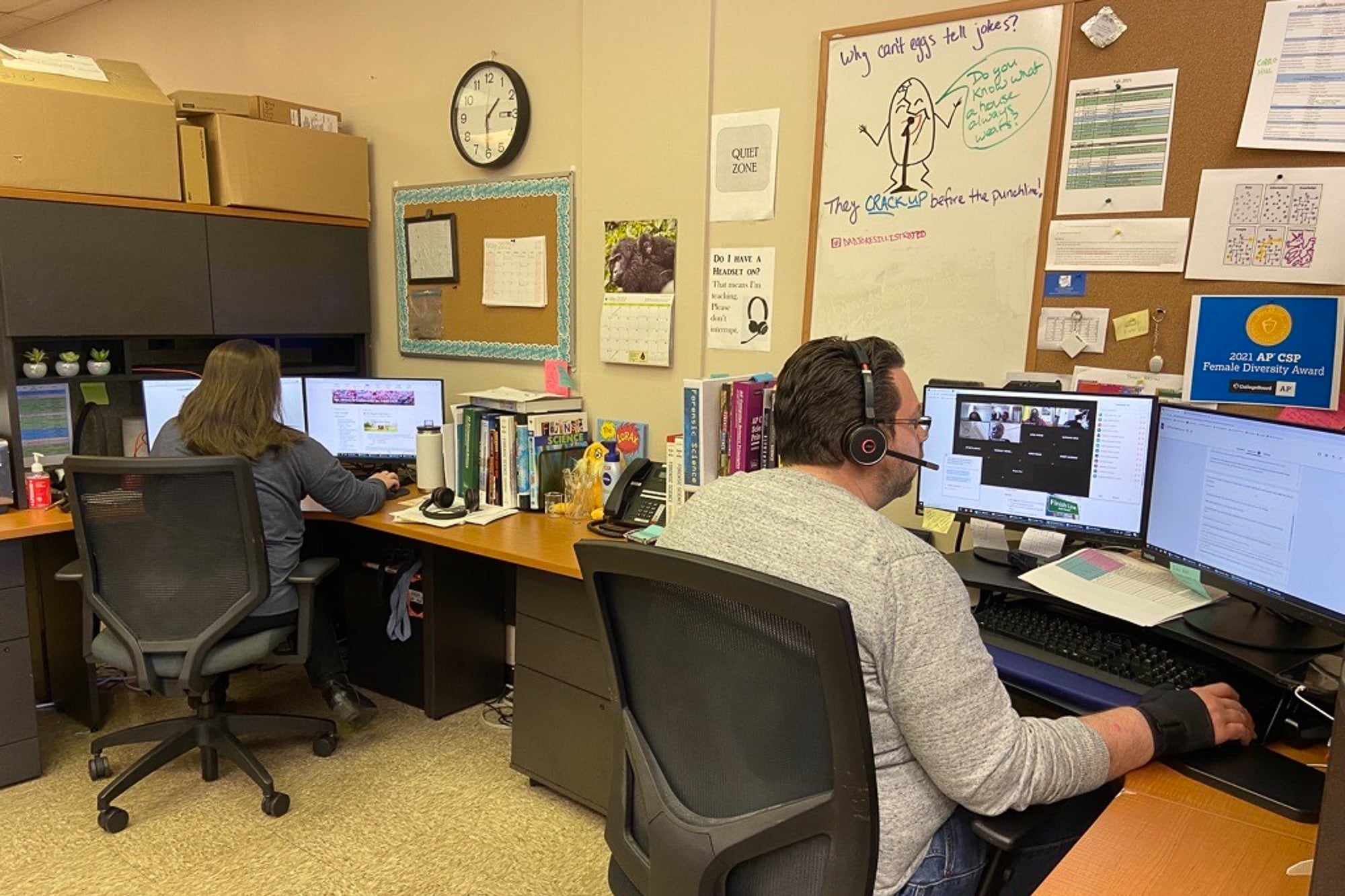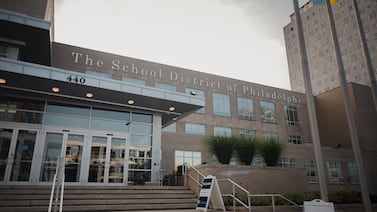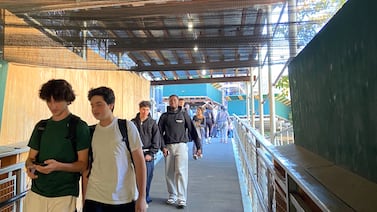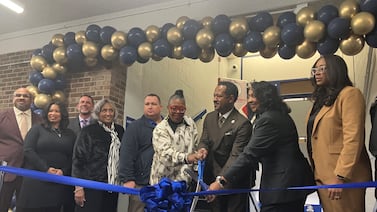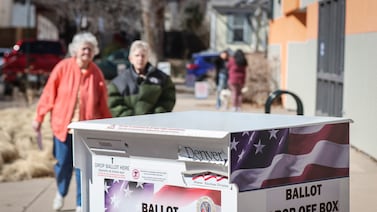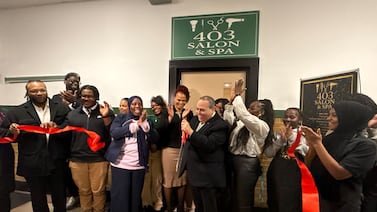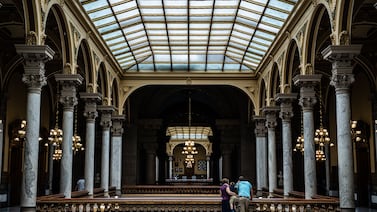As a student two decades ago at Brooklyn Tech, the city’s largest high school, Fuad Chowdhury marveled at the seemingly endless selection of courses at his fingertips.
Years later, when Chowdhury became the assistant principal of Bronx Compass, a small public high school, he was disheartened that he could only offer his students a small fraction of that variety. Bronx Compass enrolls roughly 400 students, and, like small schools across the city, doesn’t have the budget or manpower to offer a wide range of classes.
“I love small schools, unfortunately the drawback is I cannot necessarily have a music teacher and an art teacher and a computer science teacher,” Chowdhury said. “I’ve always felt it painful when I can’t offer a course that I know I have some students interested in, but not enough to rationalize a full course.”
So when Chowdhury heard about a new education department program that could expand his school’s course selection, he leapt at the chance.
Bronx Compass is now one of nearly 60 schools across the city participating in a fast-growing initiative that brings virtual courses to small schools without the bandwidth to run them in person.
The program, which launched as a small pilot in 2018, allows students to take online courses taught by public school teachers in other parts of the city from the comfort of their own school buildings and with supervision from an on-site staff member.
The initiative leapt in size this year with an infusion of federal relief funding, and now reaches roughly 1,500 students across 58 schools, with 23 separate courses taught by a mix of fully virtual teachers and in-person teachers who lead online courses outside traditional school hours.
At Bronx Compass, there are more than 20 students this year enrolled in a mix of virtual AP Computer Science, AP Art History, and AP Statistics courses.
“My larger dream for how I want to use virtual learning in our school community … is saying that we can offer any course,” said Chowdhury. “That’s a powerful statement.”
Educators see the expansion of virtual learning classes as an equity issue. The city’s smallest high schools are disproportionately concentrated in poor neighborhoods with higher shares of Black and Latino students, according to education department data.
“When I think about scaling this up, I think it all goes back to giving kids a voice in what they get to take, and breaking barriers that prevent an equity of access to coursework and learning,” Chowdhury said. “I think this could … I don’t want to say to break down those barriers, but at least to move them out, make them more malleable.”
NYC’s small schools are getting smaller
For decades, New York City has sustained hundreds of small schools, following a push by former Mayor Michael Bloomberg to break down dozens of troubled larger high schools into smaller ones.
The tiny school trend has accelerated in recent years as the city’s public school enrollment began falling before the pandemic and cratered over the past three years.
As of last year, the city had 201 schools with fewer than 200 students, and 638 with under 400 kids. Fifteen years ago, in 2007, there were 99 schools with less than 200 students and 420 with fewer than 400 kids, according to education department numbers.
At the high school level, where course variety is most important, there are 210 schools with fewer than 400 students, and 111 with more than 600. And the tiny schools aren’t evenly distributed: They’re clustered in the South Bronx, Upper and Lower Manhattan, and Central Brooklyn, according to the education department.
Many educators and students say they appreciate the tight-knit communities that form in small schools, and research points to some benefits, but the tradeoffs are clear.
“It was really painful to see how difficult it is for small schools to be equitable and offer things that some of the big schools can offer, just because their hands are pretty much tied,” said Jeffrey Ellis-Lee, a teacher at Maxine Greene High School for Imaginative Inquiry in Manhattan, which enrolled just 115 students last year.
Small schools have long looked for ways to pool extracurricular resources like sports teams, and some in shared buildings have experimented with combining academic courses with co-located schools, but that “only goes as far as what you have in the building,” Chowdhury said.
The virtual classes program started as a pilot in 2018 to try to change that.
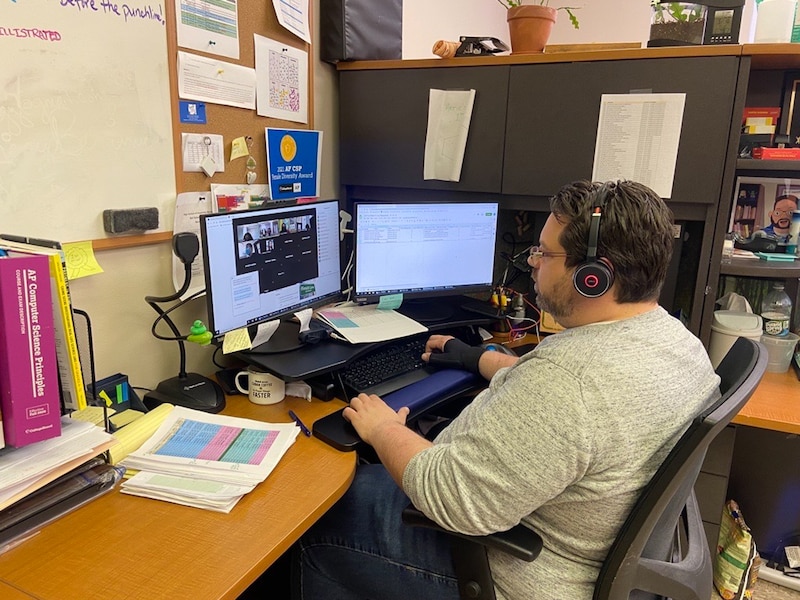
The pandemic sharply accelerated the program’s growth — exposing the entire city to online learning in one fell swoop while accelerating the enrollment losses that squeeze small schools hardest.
The education department invested $2 million in federal relief dollars this year to fund a major scale-up in the initiative. The funding for the virtual teachers comes out of a central pot and is not deducted from schools’ budgets.
“The number of schools has gone up by leaps and bounds,” said Brian Nagy, a full-time virtual teacher who’s been in the program since 2019. “That was really the whole point: for us to be able to kind of spread the wealth.”
New initiative improves on pandemic remote learning
One of the biggest obstacles to generating interest in the new program was convincing students and teachers that this version of virtual learning would be more successful than the one they encountered during the pandemic.
Once teachers and students signed up, it didn’t take long to notice the differences.
“Pretty quickly I was like, wow this is very different,” said Ellis-Lee, who is teaching AP US History and AP Human Geography virtually this year. “The kids are in a classroom in their school, they’re not sitting in their bed. There’s none of that trauma that we had to go through, thank God. And they also have a live, certified teacher that they already know in the room with them.”
The partnership between the on-site and virtual teachers is a key ingredient, often amounting to a “co-teaching” relationship, even when the on-site teacher isn’t an expert on the specific content area of the course, educators say.
The on-site teacher can monitor behavior and engagement in real time, troubleshoot technology issues, check in on students having attendance or emotional challenges, and keep the virtual teacher looped in on the grading policies and scheduling constraints of the students’ home school.
“Having someone who can just go over and be like, ‘Hey, you doing okay?’ That’s really, really important,” said Nagy.
The other big thing that separates the virtual classes initiative from pandemic remote learning is the quality of the teaching and materials, students and staff said.
While schools experimented with different platforms during the pandemic, courses in the virtual learning initiative follow a stable format — with assignments posted on the platform iLearn, and a Zoom links for live instruction placed in the same place every class.
“Everything is organized,” said Taina Nieves, a junior at Bronx Compass taking virtual AP art history this year.
Teachers participating in the program are, by and large, veterans who have interest in and experience with remote teaching, said Shana Covel, the program’s director.
“I think my favorite part about it is the teacher,” said Alexis Frye, a 15-year-old 10th grader at Bronx Health Sciences High School who is taking Spanish 5 virtually this year. “She takes the time out to make sure everyone is on the same page.”
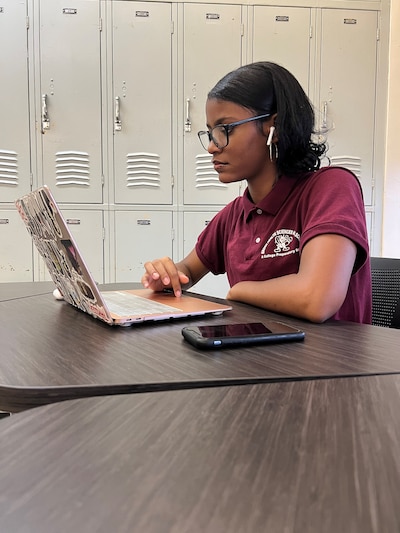
That’s not to say there aren’t drawbacks. Tech issues still frustrate staff and students. Scheduling conflicts force some of the virtual courses outside of normal school hours, making it harder to sustain participation. And some teaching strategies — particularly involving group work — are harder to pull off virtually.
“I’ve had really great in-person debates,” said Ellis-Lee, but in the virtual setting “kids are still hesitant to turn on cameras and talk. Eventually we got around to having a really great debate … it just took a lot more support.”
Educators eye more growth
Virtual learning classes have already transformed the course catalog at Bronx Health Sciences High School. In the year-and-a-half that the school has been participating, administrators have been able to offer roughly 20 virtual courses, including AP Government and Politics, AP Environmental Science, and advanced Spanish and French courses. And 75 students are currently participating, according to Assistant Principal Brian Artzt.
Before the virtual courses, Bronx Health Sciences offered only two AP classes at a time.
“It changed the game of what we could even provide for our children,” Artzt said.
Supporting schools like Bronx Health Science takes a lot of behind-the-scenes logistical maneuvering from the DOE’s central office, including lining up the class periods of multiple schools across the city with different bell schedules and finding the teachers with the right qualifications.
“That’s my logic puzzle,” said Covel, the program’s director.
Educators hope those logistical challenges will become more manageable as the program grows.
“It’s like a business model: As it scales up you have more drivers for your trucks, you have more pallets to move your items, things are going to be easier,” said Chowdhury.
Just how big the program could get is still an open question.
Covel said, “We don’t have a quota or numbers attached to it. It’s very much just continuing to meet the needs of schools.”
Artzt, the Bronx Health Sciences assistant principal, thinks the program “should be across the city. It should be everywhere.”
Taina, the Bronx Compass student who’s taking AP Art History virtually this year, agrees.
“It opens that door to possibilities that a lot of kids may have thought were not possible,” she said. “If it was something to become bigger it would make a difference for a lot of other kids.”
Michael Elsen-Rooney is a reporter for Chalkbeat New York, covering NYC public schools. Contact Michael at melsen-rooney@chalkbeat.org.

